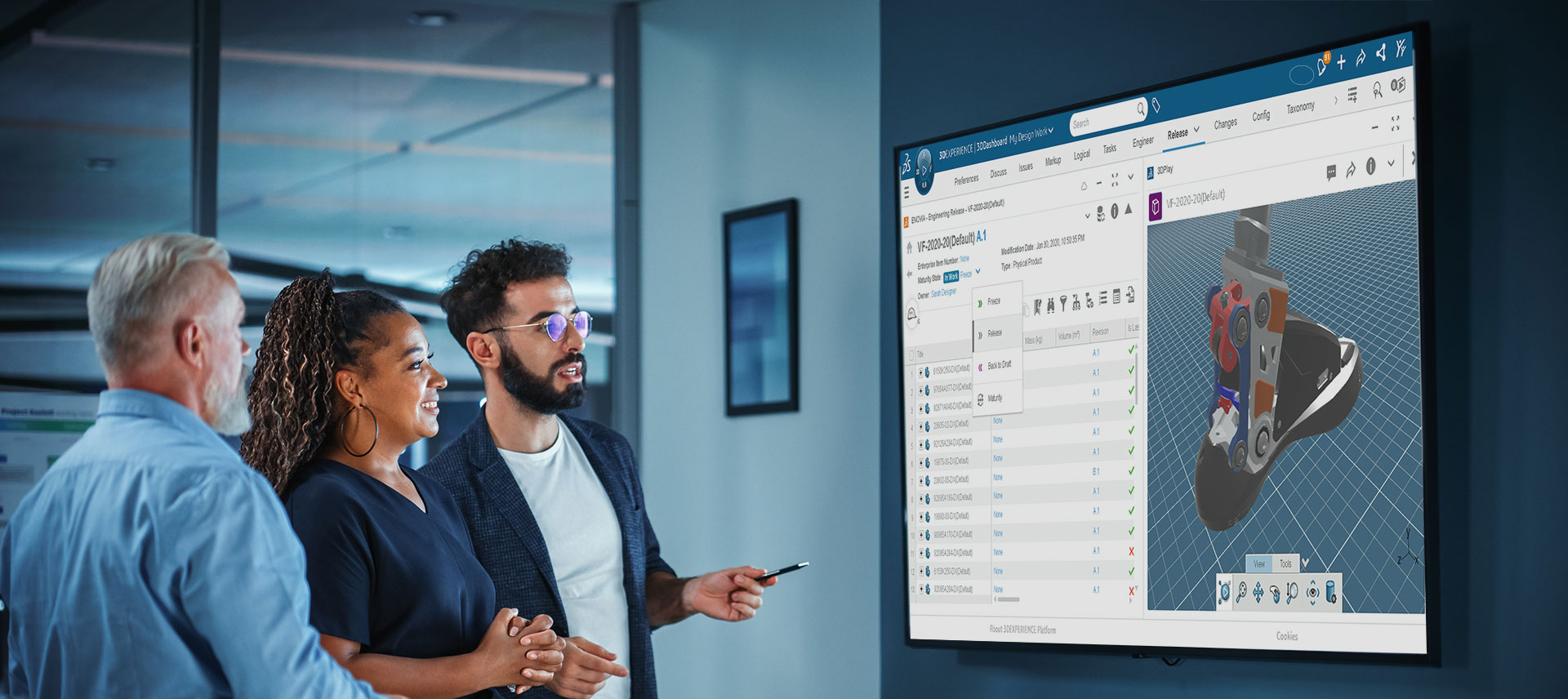Collaborative Product Development
Enhance product innovation and accelerate market delivery through effective collaboration
What is Collaborative Product Development?
Collaborative Product Development (CPD) is a strategic approach that empowers organizations, teams and stakeholders to work in harmony on product development initiatives. By leveraging connected software, integrated workflows and centralized communication channels, CPD ensures streamlined collaboration across every stage of the product lifecycle.
This unified methodology drives innovation, lowers development costs, enhances product quality and accelerates time-to-market, all while staying aligned with strategic business goals. When CPD is applied to managing product definitions across extended enterprises, it is referred to as collaborative Product Definition Management (cPDM).
The 3DEXPERIENCE platform plays a pivotal role in enabling CPD. It offers a cloud-based environment that unifies multi-discipline data, breaks down silos and facilitates collaboration among global teams, regardless of location. Equipped with advanced features like product lifecycle management, design simulations and real-time collaboration, the platform addresses complex engineering challenges in a unified digital workspace. Teams can co-develop designs, validate ideas and simulate performance in various scenarios, ensuring accuracy and efficiency throughout the process.
Additionally, the platform’s robust cPDM capabilities centralize product data management, providing consistency and streamlining operations across the entire organization. By utilizing the 3DEXPERIENCE platform, businesses can amplify their efforts, fostering innovation, precision and operational excellence for a competitive edge.
Core Pillars of Collaborative Product Development
Unified Communication and Development Framework
CPD serves as a central hub, integrating communication, workflows, and resource sharing among contributing teams. This seamless environment eliminates inefficiencies and ensures that every contributor is aligned with broader project objectives.
Streamlined Cross-Functional Processes and Task Management
By integrating tasks across disciplines, CPD enables consistent and transparent workflows throughout the development lifecycle. This integration helps manage tasks efficiently, transitioning them from ideas to actionable plans while keeping development phases aligned and timelines on track.
Centralized Data for Enhanced Decision Making
A comprehensive collaboration environment provides centralized access to critical data, offering 360-degree visibility into workflows, progress, and outcomes. This shared repository ensures stakeholders have the insights needed for key decisions, enhancing predictive planning and operational clarity.
Optimized Time-to-Market and Resource Allocation
CPD's streamlined workflows and integrated tools reduce time-to-market and optimize productivity. Efficient resource allocation ensures that teams can focus on innovation and quality, aligning every development phase from ideation to execution with clear organizational priorities.
Strategic Alignment and Robust Performance
Every aspect of CPD is designed to align with strategic goals, ensuring that the development process is guided by organizational priorities and achieves high program performance. This strategic focus aids in maintaining robustness in task management and overall project execution.
Collaborative Product Design and Development in Sustainability
Eco-Conscious Design for a Greener Future
Sustainable innovation starts with collaboration. By integrating sustainability best practices into every stage of product design and development, companies can reduce environmental impact while enhancing efficiency and performance. The 3DEXPERIENCE platform leverages advanced engineering tools and seamless team collaboration to drive eco-conscious decision-making, from material selection to lifecycle assessment.
By uniting experts across disciplines, businesses create products that are not only innovative but also environmentally responsible, ensuring a greener future without compromising on quality or functionality.
When you look at sustainability, 80% of the decisions affecting the environmental impact of new products and services are taken during the design phases, usually with traditional methods of measurement. We are getting this information too late in the product development process to actually be able to address the impact unless we do very expensive changes.
Collaborative Product Development Across Industries
Discover how CPD enhances unification, enablement and collaboration by leveraging integrated workflows across industries.
Transform Operational Performance with Collaborative Product Development
Adopting Collaborative Product Design and Development best practices is a strategic leap forward, empowering organizations to innovate, streamline operations and lead in today’s competitive landscape. Start your transformation.
Engineering Project Management
Drive complex projects to completion on time and on budget using tools that connect design data with project tasks to streamline workflows and ensure traceability.
Supplier Management
Ensures seamless integration, cost efficiency, and the reliability required for managing global supply chains.
MBSE- Model based Systems Engineering
Revolutionizes design processes by enhancing system-level visibility, consistency and adaptability across project lifecycles.
Multi-Discipline Product Development
Collaborate seamlessly across disciplines, integrate processes effortlessly and drive efficiency to deliver innovative products with precision and agility.
3D Product Visualization
Visualize, analyze and refine designs with unmatched precision and clarity, enabling clear communication and collaborative innovation.
Product Review & Validation
Ensure accuracy, compliance and efficiency by reviewing and validating products with real-time insights and comprehensive traceability.
PLM Analytics
Utilize data insights, optimize processes and drive informed decision-making with comprehensive product and project intelligence.
ALM- Application Lifecycle Management
Manage software source code variability and effectiveness in the context of a multidisciplinary product structure for clear traceability and governance.
Change Management
Bring the organization together under a single change methodology to streamline change activities with strict controls and full traceability.
Issue Management
Identify, analyze and resolve issues with full traceability and real-time access to relevant information.
Requirements Management
Bridge design intent with deliverable outcomes using clear, traceable requirements.
Use cases: Driving value through Collaborative Product Development
Product Lifecycle Management
Accelerate innovation with ENOVIA's Next-Gen PLM, unifying teams, data and processes seamlessly for more agile product development.
Virtual Product development
Streamline product design and validation virtually with ENOVIA, improving collaboration, reducing costs and accelerating market readiness.
Collaboration & Intelligence
Leverage ENOVIA Collaboration Intelligence across the enterprise for data-driven insights, smarter decision-making and improved team collaboration.
Key Benefits of Collaborative Product Development
Want to Learn More?
Explore the content below to learn more about Collaborative Product Development.
Customer Stories
How Leading Companies are Using our PLM Solutions
automation.eXpress
Inside the automation.eXpress facility, employees collaborate seamlessly across departments using the 3DEXPERIENCE platform, turning complex machine concepts into fully realized automated solutions. The entire team at automation.eXpress finds the process of moving from the design stage to the manufacturing and production stage seamless due to the platform’s data transparency.
With the amount of people who work on a singular project, having one unified platform is essential for collaboration.
I would say that we are 25% more efficient.
FAQs On Collaborative Product Development
Learn What ENOVIA Can Do For You
Speak with an ENOVIA expert to learn how our solutions enable seamless collaboration and sustainable innovation at organizations of every size.
Get Started
Courses and classes are available for students, academia, professionals and companies. Find the right ENOVIA training for you.
Get Help
Find information on software & hardware certification, software downloads, user documentation, support contact and services offering.









